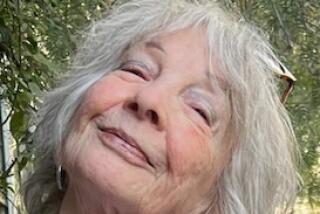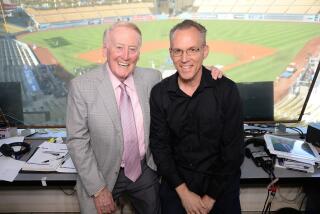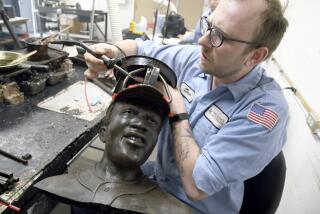Rachel Robinson’s Homecoming : She Recalls a Legend and Her Days in L.A.
Long before she met Jackie Robinson, and long before she stood beside him as he broke major-league baseball’s color barrier, Rachel Isum regularly walked to the Exposition Park Rose Garden from her house a mile south on 36th Place in Los Angeles.
Her mother, a gourmet cook and caterer, took her to violin lessons or to the Huntington Museum in Pasadena to see classic art works. But aside from the local Bethel African Methodist Episcopal Church, the Rose Garden was among the few places Zellee Isum would let Rachel go to unchaperoned.
Five Decades Later
Five decades later, Rachel Isum Robinson returned to the park this week, now a graying grandmother living in New York and representing her late husband in ceremonies across the country during this 40th anniversary year of his integration of the majors.
She had come back home to promote “Jackie Robinson: An American Journey,” a traveling exhibition on his life that opens Friday at the California Afro-American Museum. But amid the displays commemorating her husband, it was memories of the Rose Garden next door that captured her imagination and rekindled thoughts of a Los Angeles at once comfortably familiar and yet distinctly different from the city she knew half a century ago.
“I loved the Rose Garden,” she said wistfully as she walked along Figueroa Boulevard toward the museum. “Coming back here I get that feeling of full circle; of a life all laid out for me to understand.”
Her father, she remembers, “was extremely proud of California being his native state and of being a pioneer. He transmitted that to us and I still feel that way.
“He lived in Chico before he came here and his mother and father lived in the same rented place for 40 years and when his father died, the landlord evicted his mother. That was an object lesson for him. He always said that home ownership was the only key to security.”
Her family bought their home on 36th Place in 1908. Rachel Robinson recalls a white-framed cottage, in a neighborhood of blacks, whites and rapidly arriving Japanese. The house today is owned by her brother, Raymond, and she sometimes stays there on her periodic visits to Los Angeles.
There is still a “lifelong neighbor who lives two houses from us in the same house. In the next block, I went by yesterday and found the same family there as when I was an infant,” she added. “My grandmother lived on 35th Street and my older brother still owns that house, although he doesn’t live in it.”
Robinson drove around the old neighborhood shortly after she arrived, and recalled that the mix of people worked well. Although a nearby theater required blacks to sit in the balcony and a hamburger stand next to it refused to serve blacks, she said, the Isums felt at home.
Church Was Important
“Within a two-mile radius, I had everything I needed to support my growth. The church was central to our social activities. It wasn’t something where you needed to have money or any social resources. It was available to you even as a non-religious type of thing.
“I carry 36th Place in my psyche,” she added. “It means . . . being secure.”
When it came time to break away from that security and enter college, Robinson had few problems. A top student at nearby Manual Arts High School, she won a scholarship from a civic group and had no trouble getting into UCLA.
The few black students on campus congregated in the corridors of Kerckhoff Hall, she recalled, and that was where she first noticed a young man with a certain aura and a lot of people always hanging around him.
His name, she learned, was Jackie Robinson, and he was a four-sport letterman.
“He was big, he was broad-shouldered, he was very attractive physically, and he had pigeon toes you couldn’t miss,” she said.
“He was also proud of his color, which was something many of us didn’t have at that age.
“Jack displayed his color by wearing white shirts. . . . There was a kind of dignity about him and a sense of purpose that attracted me. I didn’t know what that was or what it was going to come to.”
As her impressions became clearer, Rachel Isum’s respect for Jackie Robinson grew, but she doubted that the two would ever become friends “because I was the freshman and he was the college hero.”
However, she remembers arriving early at her UCLA parking lot so that she could watch for him. Too shy to approach him directly, she hoped that if she casually ran into him while walking to class, she might get to know him.
Soon afterward a mutual friend introduced the two and, according to Jackie Robinson’s autobiography, “I Never Had It Made,” Rachel’s looks, honesty and understanding captivated him.
They began a five-year courtship, although much of it was spent apart while Jackie played football in Honolulu and served in the U.S. Army and Rachel attended nursing school in Los Angeles and San Francisco.
Wanted to Get Her Diploma
Spats occurred, but Jackie wanted to get married and wrote her daily love letters and sent her a box of candy every week. Rachel refused to wed until she completed her college degree. She was the first of her family to have a chance to finish college and felt personal and family pressure to get her diploma before she settled down.
When she graduated in the summer of 1945, she and Jackie set a wedding date for Feb. 11, 1946. Jackie would be 27; his bride would be 23.
But before that, history stepped in. Jackie had just completed a season playing baseball with the Kansas City Monarchs of the Negro Leagues and thought he would eventually become a high school coach in Los Angeles.
But the opportunity to break baseball’s half-century-old color line came during a meeting with Brooklyn Dodgers president Branch Rickey on Aug. 28, 1945, at which Robinson was promised a contract. After that Brooklyn meeting, Robinson called his bride-to-be in Los Angeles.
“He told me about the meeting and also said to keep it a secret . . .” Rachel Robinson said. “We just didn’t grasp the significance. It was more or less the chance for a good job. We had no real appreciation of the circumstances.
“We were not real, real young, and we had known each other a long time, and we had a lot of confidence in each other, so it wasn’t as frightening as it was exciting,” she added.
“The fact that he made me a partner in all these things (decisions) also helped in that I was ready and able to be that kind of partner rather than a kind of subordinate or someone left on the side or someone that you take out your frustrations on. I think that helped make it more challenging than hard.”
Jackie Robinson played at Montreal in 1946 and then overcame racial slurs and other forms of derision to hit .311 over a 10-year major-league career. After his retirement from baseball in 1956, he worked as a vice president of personnel for a restaurant chain, became a close adviser to New York Gov. Nelson Rockefeller and was active in numerous civil rights causes. In 1972, he died from complications of diabetes at 53.
The free exhibit at the museum, which consists of film clips, 175 photographs and 200 artifacts, including letters, uniforms and other memorabilia, will start Friday and run everyday through Nov. 15 from 10 a.m. to 5 p.m..
Rachel Robinson recalled her husband as a multifaceted individual, much more than an athlete, a person who continued the sense of purpose she first noticed at UCLA.
“What he did in the post-baseball years was building on what he did during the baseball years,” she said. “I think as time went on he was drawn out of baseball. He was not clinging to it as the only form or way of life for him.”
Rachel Robinson, who runs the Jackie Robinson Foundation, which provides scholarships for minority youths, is promoting her husband’s exhibit “. . . to see to it that the spirit and the legacy he left us is applied; that it gets used.
“There’s a constant need to combat racism but also to hold up an example to young people that they can change things; that they can have a quality life; that they can absolutely have some conviction about being able to master their environment and become something important.”
Her own environment has always been very important to her. Robinson, who has taken several trips to Africa to explore her roots, was “very excited” to be back home again.
“I cherish and value every experience I’ve ever had; the painful ones, the good ones,” she said, “because that’s what makes up my life; that’s what makes up me.”


